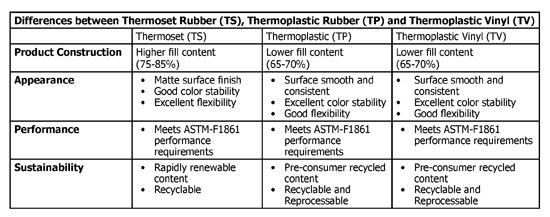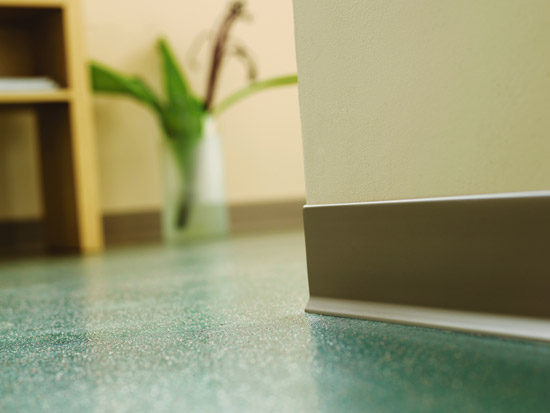New Sustainable and Aesthetic Options in Finishing Borders (Wall Base)
Recycle Wall Base
Specifying wall base that can be recycled makes it possible to divert these materials from the landfill, once its time as wall base is over, and repurpose them to be used again and again.
Recycling TV, TP, TS
Thermoplastic wall base, like TV and TP wall base, can be ground up and reprocessed, allowing it to be recycled in a wide variety of ways. Thermoset materials, like TS wall base, are more limited in the ways that it can be recycled; because the chemical curing process that gives the TS wall base its initial form changes the material at a molecular level and makes it impossible to reshape it. When reheated, thermoset materials will decompose before melting, so TS wall base can be ground up and used as filler in other products, such as playgrounds, or mulch, but it cannot be melted down and reshaped.
 |
Although all compliant with ASTM performance requirements, TS, TP, and TV wall base do appear different, perform differently, and embody different sustainable characteristics. Photo courtesy of Tarkett |
New Bio-Based Wall Base
Technological advancements and material innovation now make it possible for designers to specify a new bio-based wall base that offers sustainable characteristics that are far beyond anything available in the more traditional TV, TP and TS materials, without sacrificing performance. This more sustainable wall base solution meets all of the performance requirements of the ASTM-F1861, Standard Specification for Resilient Wall Base.
 |
New bio-based wall base contains rapidly renewable resources that include: walnut shells, pine rosin, and vegetable oil. Photo courtesy of Tarkett |
This new bio-based wall base contains rapidly renewable materials that include walnut shells, pine rosin and vegetable oil. Even the fillers in this bio-based solution are natural materials like walnut shells and oyster shells. The sustainable nature of this product enables it to be used to contribute toward earning LEED points in the satisfaction of the LEED MR credit 6 (MRc6) entitled 5 Percent Rapidly Renewable Content.
Beyond containing more readily renewable materials, the bio-based wall base is phthalate-free and PVC-free, like TS wall base, but is manufactured in a more energy efficient process than the chemical curing that TS requires. These materials can also be reprocessed and repurposed into a wide variety of products.
New Options for a Wood Wall Base
Designers are looking for more than sustainable wall base solutions. New wall base products are emerging to support the current trend in healthcare settings where institutions are being designed to convey a more residential look and feel. Designers are increasingly incorporating more wood and wood-aesthetic throughout a space. Now resilient wall base products are available in a wood finish that will achieve the warmer, residential appearance, without opening the space to the performance issues, like cracking or separating from the wall, commonly experienced with traditional wood wall base.
 |
New wood finish resilient wall base products offer the warmth and aesthetic appeal of wood in a solution that is resistant to cracks and scuffing and able to withstand rigorous cleaning and harsh disinfectants. Photo courtesy of Tarkett |









